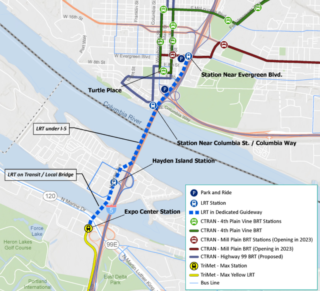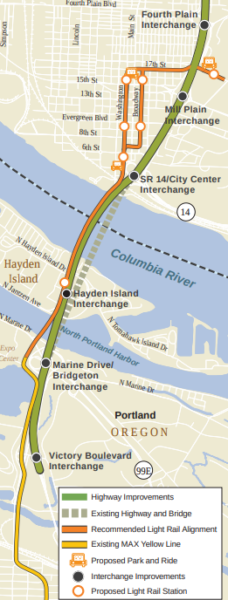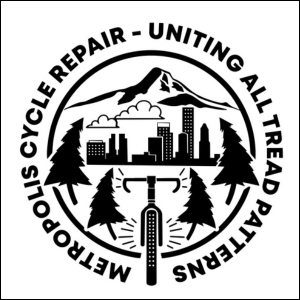
Yesterday we covered the announcement that the highway footprint for an expanded I-5 between Washington and Oregon had been narrowed down to two options: an expansion nearly identical to the 2013 Columbia River Crossing project and an option with one fewer “auxiliary lane” in each direction. At the same time as that announcement, the project team also announced they have narrowed down the options for high-capacity transit between Expo Station and Vancouver to one.
After studying 11 different options for either light rail or Bus Rapid Transit (BRT), the option recommended to move forward is a light rail line that is directly adjacent to I-5, avoids heading directly into downtown Vancouver and terminates at Evergreen Boulevard, right next to the Vancouver public library.
Since the failure of the Columbia River Crossing project a decade ago, C-TRAN has moved forward with building out its Bus Rapid Transit network, with the 4th Plain line having opened in 2017 and the Mill Plain line under construction now. So why wasn’t BRT selected here? Primarily the ability of light rail to move more riders. Capacity constraints on BRT impact how many riders can fit on each bus, and most riders will be transferring to light rail at Expo Center anyway, adding travel time.
Significantly, the IBR team noted this week that their models are currently forecasting more demand for transit across the Columbia River than any of the options they have studied so far even allow. In other words, the model projects some people who want to take transit will end up driving instead. “Transit demand exceeds peak 1-hour capacity on all modes of transit crossing the river. The mode share numbers shown assumes excess peak 1-hour demand cannot be accommodated and therefore has been shifted back to the auto mode,” a presentation footnote stated.
Advertisement

But the choice to run light rail directly along I-5 will likely prompt a lot of scrutiny. Avoiding the downtown core of Vancouver limits the walkshed of the stations, and having a massive highway next to a light rail station intended to attract riders is simply not ideal. But the fact that this alignment would have fewer property impacts was cited as a primary reason it’s moving forward. In addition, a desire not to “duplicate” the BRT service that runs along Washington Street and Broadway was cited. But duplication is not necessarily a bad thing: it reduces transfers and makes transit easier to use. The downtown Portland transit mall works well because so much service overlaps.
At Monday’s IBR Equity Advisory Group meeting, Matt Hines of Activate Inclusion raised concerns about the fact that the light rail alignment won’t provide a direct connection to Clark College, which was planned as the northern terminus for light rail as part of the Columbia River Crossing project. “The decision for high capacity transit must reflect the need to connect Portland east of I-5 in Vancouver,” because such a connection doesn’t currently exist that’s easy for people with disabilities to use, he said.
Of course, light rail is a political symbol in addition to being a mode of transit. At a legislative committee meeting on Thursday, State Senator Lynda Wilson (R-17), who represents the eastern portion of Vancouver, signaled she was ready to vote no on approving the project with light rail included. Senator Wilson, throwing out suggestions that TriMet’s light rail system is in bad financial shape, repeatedly expressed skepticism that light rail would have a lower cost-per-rider because it has higher capacity. “I don’t think laying rail is going to be cheaper in the long run than buying another bus. I don’t see how this ever pencils out,” she said.
Wilson was joined by Representative Jaime Herrera Beutler, who represents the entirety of southwest Washington in Congress. “I could not be more disappointed by today’s announcement that I-5 bridge replacement officials are advancing two final project options that do not include Bus Rapid Transit, while both would extend Portland’s light rail system into Clark County,” she wrote in a Facebook post Thursday night. “This decision flies in the face of Southwest Washington voters who have soundly and repeatedly rejected bringing Portland’s light rail to Washington state along with the massive cost, river traffic limitations and public safety concerns that come with it.” Light rail bringing additional crime to an area is a conservative trope that frequently pops up in discussions of transit expansion here and elsewhere. But the pushback on light rail in Clark County is likely contributing to the final decision not to deviate from I-5’s footprint there.
Representatives from both TriMet and C-TRAN came out in strong support of the option to terminate at Evergreen, and it seems likely that many other elected officials weighing in on the project overall will defer to those agencies when it comes to the high capacity transit alternatives. Whether politics can derail the decision now remains to be seen.
CORRECTION, 4/25 at 3:20pm: This story originally misidentified Matt Hines of Activate Inclusion. We regret the error.

